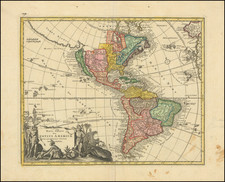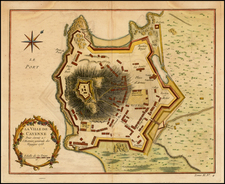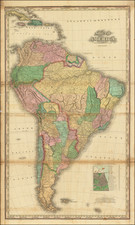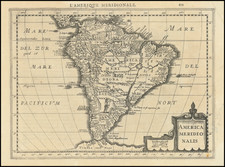Fine wide margined example of Kircher's fascinating map of America, from his Mundus Subterraneous, first issued in 1665.
Kircher was a Jesuit scientist who founded the Museo Kithcerianon in the Collegio Romano in Rome. This map was used to illustrate one of his most famous and influential works, a study of the world's ocean currents, tides, volcanic distribution, and core structure of the planet. The map is remarkably accurate for the period, altough the massive crater at the headwaters of the Amazon River is certainly a curious addition to the map. The primary purpose of this map was to illustrate the Ocean's currents, and in that regard, it was remarkably accurate, surpassing the work of Robert Dudley, who illustrated only the local currents in the regions covered.
The map has grown increasingly scarce on the market in recent years. A crisp dark impression of this fascinating map.
Athanasius Kircher (1601-1680) was a Jesuit priest and a well-respected scholar known for his role in disseminating knowledge. Kircher was educated in Greek, Hebrew, and the humanities at Fulda, Paderborn, Cologne, Koblenz, and Mainz. After fleeing the Thirty Years’ War in Germany, Kircher worked as an academic at Avignon and, from 1634, Rome.
In Rome, Kircher served as an intellectual node, spreading information sent from around the world by Jesuit missionaries. Particular interests included ancient Egypt, astronomy, mathematics, medicine, music, and languages (both ancient and modern). He also made several maps and was a geographic compiler. It is likely he was the first person to depict the Pacific Ring of Fire on a map.
Kircher combined a mixture of hermeticism with nascent scientific inquiry, gaining him a reputation as one of the final Renaissance men. For example, he observed the eruptions of Etna and Stromboli. He had himself lowered into the crater of Vesuvius soon after an eruption to observe the changes wrought by the cataclysm. He experimented with bioluminescence by seeking the applications of firefly extract as a light source. He also made the first known Aeolian harp.
Kircher wrote 44 books, while over 2,000 of his manuscripts and letters survive. He also assembled one of the first natural history collections, the Museo Kircheriano or the Kircherianum, which was broken up after his death and became the foundation of several institutional collections.









![[ Rare Group of American Maps Published in Prague ] Neueste Länder und Völkerkunde. Ein geographisches Lesebuch für alle Stände . . . Funfzenter Band America Mit Charten . . . 1818](https://storage.googleapis.com/raremaps/img/small/102973.jpg)

![[Spectacular Set of Wall Maps of the Continents Dedicated to King Charles II of England, &c.]](https://storage.googleapis.com/raremaps/img/small/93614.jpg)


